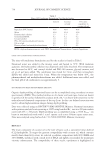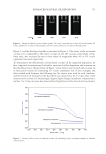691 MOISTURE IN THE CUTICLE SHEATH cracks increases (see Fig. 2a to 2d). Between 90% and 95% RH, the small buckling patterns are accompanied by large transversal circular cracks that form around the whole cuticle sheath (see Fig. 3a). At 100% RH, or when the fiber is immersed in water, no cuticle cell lifting can be observed. Instead, only deep transversal circular cracks and the detachment of the whole cuticle sheath from the cortex is observed (see Fig. 3b). It should be mentioned, however, that the latter phenomena only occurred with cyclical elongations higher than 25%. This means that at 100% RH, most of the hoop or Poisson contraction stresses are dissipated by moisture plasticization and no interlayer failure or cuticle cell lifting occurs. Thus, it becomes clear that, when the individual cuticle cell layers (i.e., the epicuticle, exocuticle, endocuticle, and CMC) have high levels of moisture, their moduli are such that they have a higher degree of interlayer mechanical compliance. This means that at 100% RH and elongations higher than 20%, there is no build-up of shear, tensile, or hoop stress concentrations across the individual junctions of the cuticle cell intra layers. Rather the assembly of cuticle cells behaves as a single pipe-shaped body. As a result, under these conditions, stress dissipation does not occur by cuticle cell delamination of individual cuticle cell intra- or interlayers. Instead, the cuticle sheath behaves as a solid pipe that undergoes tensile cracking and detaches from the cortex. The latter phenomenon indicates that at high elongations when the fiber is water swollen, the cement between cuticle sheath and cortex breaks because of a mismatch in extensibility between the water plasticized cortex and cuticle sheath (see Fig. 3b). CUTICLE CELL LIFTING OR BUCKLING BY THERMAL AND MECHANICAL STRESSES During the experiment’s development, it was found that lifting and buckling of cuticle cells could also be produced by elongations lower than 5%, provided that thermal stresses Figure 3. SEM pictures of hair fibers subjected to 15 cycles of 25% elongation, at different moisture conditions. Note the presence of deep transversal circular cracks accompanied by small area size cuticle cell buckling patterns at approximately 90% RH (Fig. 3a). Note also the absence of these patterns, the presence of long transversal circular cracks, and the occurrence of cuticle sheath detachment when the fiber is cyclically elongated while swollen in water.
692 JOURNAL OF COSMETIC SCIENCE are applied simultaneously to hair. Because of the combined stresses required to produce lifting, we will refer to this phenomenon as thermomechanical cuticle cell lifting. The characteristics of this type of lifting had many differences with respect to those previously discussed and produced by high elongations. Their features varied depending on the range of temperatures accompanying the low mechanical deformations. For instance, blow-drying hair in the range of 70 to 80°C while applying low levels of mechanical elongation in the range of 2% to 5% instantly produced cuticle cell delamination or lifting. Video recording techniques showed that the degree of delamination and number of lifted cuticle cells increased gradually with blow drying time (see Figs. 4a to 4c). One of the important characteristics of thermomechanical lifting, such as the one shown in Figs. 4a to 4c, is that it only occurs when the hair had been equilibrated to humidity conditions ranging between 65% and 90% RH (i.e., when the cuticle sheath had absorbed high levels of water, and when the fibers were blow dried above 70°C). Moisture conditions lower than 70% RH, or blow-drying temperatures lower than 75°C, did not produce thermal delamination. In fact, hair that had been equilibrated at 30% RH, subjected to 5% elongation, and blow dried at 90°C did not lead to thermal lifting even when the blow- drying periods were extended for 5 minutes. Conversely, hair equilibrated at high moisture contents (i.e., 90% RH) did not produce delamination when blow dried at or below 50°C. These observations clearly indicate that for thermomechanical lifting to occur, the presence of water and its rapid evaporation are necessary in the cuticle cell. The experiments showed that this type of cuticle cell delamination also occurred by breakage at the cement that joins the endocuticle of top cuticle cells and the surfaces of cuticle cells below (i.e., at the CMC see Fig. 5a). This can be deduced from the fact that when these lifted cuticle cells are broken and chipped away by friction, they do not leave endocuticular remnants on the surface below (see Fig. 5b). For this reason, we will refer to this type of cuticle cell lifting as endocuticular delamination. The mechanism for its formation is straightforward, namely, the transient and rapid water evaporation from the endocuticle causes its contraction and alters its mechanical moduli. The combined action of both processes, along with the additional hoop stresses produced by low elongations, induces a concentration of stresses across the endocuticle or CMC, causing breakage of the CMC. Figure 4. Sequential images of a hair surface taken at different time intervals from a videorecording strip showing gradual increase in cuticle cell lifting with blow drying time at 80°C: Figure 4a (10 s), Figure 4b (20 s), Figure 4c (40 s), and Figure 4d (50 s).
Purchased for the exclusive use of nofirst nolast (unknown) From: SCC Media Library & Resource Center (library.scconline.org)






































































































































